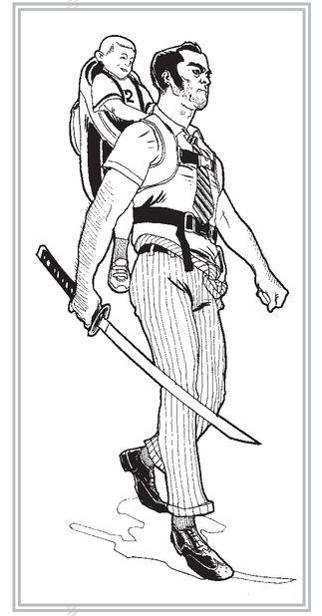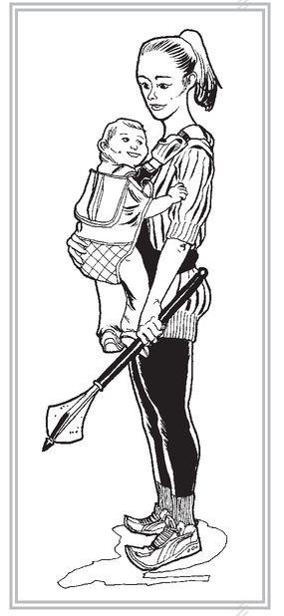The Zombie Combat Manual (23 page)
Read The Zombie Combat Manual Online
Authors: Roger Ma

Transport systems in the mobility carrier class include all back- and chest-positioned carry systems that strap the child into a harness, positioning his or her torso flat against that of the guardian. Carriers of this type hold distinct advantages over the aforementioned stroller class. They are lighter in weight, are portable, and enable hands-free use while simultaneously keeping the child close to the protector. There is a distinct difference, however, between carriers that mount the child in the front of the defender and those that mount him or her on the back.

Let’s first examine the back-mounted carriers. These are harness types that position the child across the guardian’s back and shoulders, much like a mountaineering backpack. There are benefits to positioning a child in this fashion, as it limits his or her exposure to a ghoul attacking from the front, keeping the guardian between the two. However, back-positioned carriers also exhibit some noteworthy shortfalls when confronting the living dead.
With the child on his or her back, the guardian has no visibility to any undead threats from the rear. In potentially lethal and unfamiliar situations, the child needs to be in full view of the guardian at all times. Never discount the possibility of a ghoul that has lost the ability to moan (possibly because of a severe throat wound) attacking silently from the rear. Mounting a child on your back also inhibits your ability to use an actual backpack to carry other essential supplies.
Using a back carrier sometimes requires the help of two individuals to quickly secure and mount the child. If you are traveling alone, anticipate taking more time to situate your child in the back mount; time that you may not have at your disposal.
Chest-mount mobility carriers are a favorable option when facing the undead. Unlike the back mount, you have full visibility to your child, your back is available for another storage pack, and securing your child is much quicker from the front. Most important, your hands are available for other tasks, including defense, while you can visually monitor the child’s safety. Individuals have even been observed engaging in long-and medium-range combat with the living dead while wearing one of these apparatuses. This is clearly not recommended unless you are suitably experienced in ghoul neutralization. Close-quarters fighting while wearing a child harness should be avoided at all costs, regardless of skill level.

Chest-mount carriers are also not without their drawbacks. First is the simple fact that the guardian shoulders the full weight of the child at all times during transport. With larger children, this can significantly impact a protector’s energy levels, so much so that additional rest periods may be required, during which time both child and adult are vulnerable. Those who decide to only use a mobility carrier need to ensure that they are in superior physical condition to accommodate the child’s weight for long periods of time.
The other significant drawback with these devices is the fact that, once secured in the harness, a child’s limbs and head remain largely exposed. In normal situations, this provides a degree of freedom and comfort to the child. In a world clambering with hungry corpses, these exposed limbs not only are vulnerable to attack, but may impede the guardian’s vision and mobility. This situation could prove deadly should a flailing child’s arm cross a line of sight at an inopportune time. The best method for using a chest-mounted carrier is to supplement the unit with an additional cover that secures the child’s limbs and minimizes his or her exposure to both nature’s elements and the living dead.
Slings
ADVANTAGES: LIGHT, INEXPENSIVE, HIGHLY PORTABLE
DISADVANTAGES: PROTECTOR BEARS WEIGHT, INAPPROPRIATE
FOR OLDER CHILDREN
Slings can also be considered a mobility carrier device, as they require the guardian to shoulder the weight of the child and also enable hands-free use for the defender. Styles of slings that either mount the child on the back or expose the limbs of the child suffer from the same disadvantages as the mobility carriers previously discussed.
However, a particular type of sling, one that envelops the infant completely like a peanut shell and secures him or her across the guardian’s torso, is one of the best ways to transport and protect an infant during a zombie outbreak, for several reasons:

Security:
Because exposure of your child to the external environment is minimized, there is less likelihood that an exposed limb will find its way into the mouth of a hungry corpse. The baby is also positioned lower on the guardian’s torso in a sling than in other mobility carriers, keeping his or her body out of close range of a ghoul’s snapping jaws.
Flexibility:
Not only is this type of carrier inexpensive compared to the other options discussed, it packs well into a small space and requires a minimal footprint. It also enables hands-free use by the guardian, so that he or she can execute other tasks.
Comfort:
One of the benefits of this carrier type is that it secures the child close to the guardian’s body in a soothing position. During a plague of walking corpses, there is no better time to provide maximum comfort and reassurance to your child.
Like other mobility carriers, the greatest disadvantage of the sling is that it necessitates bearing all the weight of the child during transport. This device may also be less appropriate for larger or older children. However, it is the ideal mechanism for newborns—the most vulnerable humans during a zombie attack.
Which Carrier Is Best?
Given the pros and cons of the various carriers described, which one is the ideal choice during a zombie attack? If only the answer were that simple. Just as there is no one single weapon that is suitable for every undead combat situation, there is no perfect transport system that will solve all of your child protection needs. It is therefore recommended that, if possible, you prepare one of each device described. Should you lose or damage one system, you have an alternative at your disposal. This also enables you to switch between devices depending on your outbreak situation, which will no doubt be in constant flux. Depending on the scale and duration of the infestation, you may find yourself starting with a sling, moving on to a mobility carrier as the child ages, and switching to a stroller when it is appropriate or when you can no longer continually bear the child’s weight.
If you can manage only one transport device, you should then ask yourself the following questions to help inform your final decision:
• Is the child you’re guarding a newborn, infant, or toddler?
• Do you have the strength to carry the child at all times?
• Are you alone, or will you have the assistance of a second party?
• Are you shepherding more than one child?
• Do you live in a metropolitan area, a suburb, or the countryside?
Safeguarding the welfare of children is challenging during the best of times. In a world in which the dead are feeding on the living, it may seem like an impossible task. You can, however, better prepare yourself for the situation by not only having the proper equipment, but also understanding how that equipment will perform in such dire and unusual circumstances.
COMBAT REPORT: DR. JUDITH BALLANTINE
Child Psychiatrist, Walla Walla, Washington
Dr. Ballantine agrees to meet with me before one of the dozens of seminars she conducts across the world’s secured regions, educating parents on dealing with the psychological trauma that zombie outbreaks have caused their children. Her sharp gaze and serious demeanor hint at her standing as one of the pioneers of child psychiatry as it relates to the living dead. In addition to the seminars she provides free of charge, she is a distinguished visiting professor at the newly founded Covington Child Study Center, whose specific charter is the study and treatment of children suffering from mental trauma precipitated by an interaction with the undead. Dr. Ballantine is the author of three books to help children deal with existing in a world inhabited by walking corpses. Her latest title,
Mommy’s Different Now
, addresses how guardians should educate toddlers on coping with the loss of a parent to infection. She is also a qualified senior instructor of
Shigai-jitsu
, a martial art created to combat the living dead, having received her instructor’s sash directly under tutelage from Grandmaster Eric Simonson. Before we even begin, the doctor makes it clear that her priority today is her work.
JB:
We may have to cut this short when the participants start arriving, so please, ask your most pressing questions first.
ZCM: Certainly. What should parents know about protecting their children against a ghoul attack?
JB:
I don’t use that term.
ZCM: Sorry, which term?
JB:
Ghoul.
It has supernatural connotations. Derivations of the occult. That’s not what these specimens are. I’m begrudgingly resigned to using the word
zombie
because it’s such a ubiquitous expression at this point. Sorry, I can be somewhat sensitive to the terminology. On to your question . . .
Unfortunately, the greatest threat to children during an undead outbreak is often the parents themselves. Before teaching their children about the danger of the living dead, parents must first introduce the concept of death itself. This is the first hurdle, and it’s a significant one. Addressing death is one of the least desirable discussions adults want to have with children, and based on my experience, second only to conversations about sexual education. Under normal circumstances, parents may be able to avoid this subject for some time, perhaps until their child is well into the toddler years. Some never broach the subject at all, allowing the outside world to deal with it for them. In a world filled with attacking corpses, avoiding this discussion is tantamount to child neglect and increases your child’s vulnerability at least fivefold.
Before the dead began to rise, a child’s first encounter with death was often from a nonhuman loss—typically a household pet. Some children experience the loss of an elderly grandparent or neighbor. You would occasionally read these stories in which a parent expires unexpectedly at home, and the child stays with the body for days, sleeping next to it, trying to wake it up. In a dead-infested world, a child who remains in the house when a parent succumbs to infection typically does not survive. In the postzombie era, eight in ten children have suffered the demise and reanimation of someone they knew closely—a classmate, a sibling, or, worst of all, a guardian. You see the sense of urgency we had? It was literally a life-or-death situation to make people understand that having these conversations with your child should be the highest priority.
